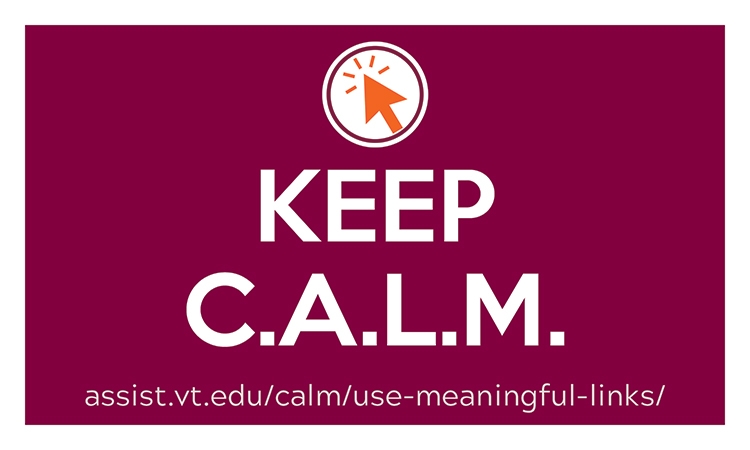Use Meaningful Links

Keep C.A.L.M. and Use Meaningful Links
As part of our Choose Accessible Learning Materials (CALM) campaign, we want you to join our Use Meaningful Links campaign. Links are an essential part of the connectedness of the internet, but also one of the most misused features. For example, "Click here" is a commonly used phrase often turned into a link or actionable button. But, it assumes that everyone can and does use a "clickable" mouse. This excludes keyboard, mobile, and assistive technology users.
Avoiding the use of non-descriptive links like "click here" is also required for meeting university policy and the law. Specifically, it addresses the Web Content Accessibility Guidelines 2.0 (WCAG) criterion 2.4.4. Make the move to links that are more clear and effective by removing "click here" and replacing it with text that describes the link’s purpose.
Why Use Meaningful Links?
Links are one of the most basic elements in digital content and essential for web content. Providing meaningful text that describes the purpose of the link is essential to help people quickly, efficiently, and accessibly use your digital documents and webpages. Because links are foundational, inaccessible links are one of the most severe barriers to accessibility. Improper links particularly disadvantages users with visual and print disabilities who often navigate a page via links.
"Click Here" isn't the only culprit either. Other commonly used non-informative link phrases are:
- here
- more
- read more
- Info
- This link
Consider the following examples:
In this example, the phrase "click here" is used multiple times. None of the links goes to the same place. In scanning the page either visually or using a screen reader it's hard to know where these links actually go.
- For a video on how to create meaningful hyperlinks, click here.
- Why accessible hyperlinks should be concise, descriptive, and meaningful. Click here to learn more.
- “Click Here” to “Read More”: Why Ambiguous Links are Problematic”. How vague links create problems for accessibility, usability, and search engine optimization (SEO). Read more.
In this revised version, the phrase "click here" isn't used. The text describes clearly where the link will take you.
- This video explores how to create meaningful hyperlinks.
- Why accessible links should be concise, descriptive, and meaningful.
- The blog titled, “Click Here” to “Read More”: Why Ambiguous Links are Problematic”, explores how vague links create problems for accessibility, usability, and search engine optimization (SEO).Tell me how
Tell me how
There is a lot of guidance on how to write meaningful link text. A few good sources are:
- Links and Hypertext from WebAIM
- Links must have discernible text from Deque University
- Links from Accessible U’s Start with the 7 Core Skills.
Join the campaign
Our goal is to reduce the number of "click here" links in campus communications. You can help us get there by sharing links to your updated meaningful links @VT_TLOS #CALMLinks or emailing examples to assist@vt.edu. Every entry is eligible for some of our Keep C.A.L.M swag.
Resources
If you’re ready to spread the word about using meaningful links, please use one of our resources below:
- Keep C.A.L.M. and Use Meaningful Links Poster (PDF | 3.7 MB) for your printing pleasure.
- Keep CALM and Use Meaningful Links Presentation for sharing the message with your colleagues.


